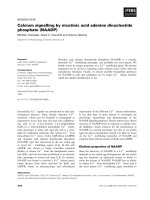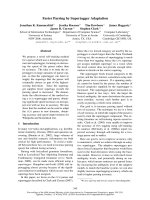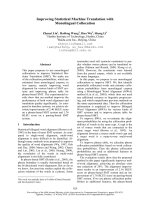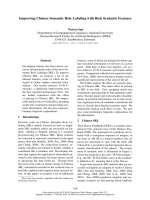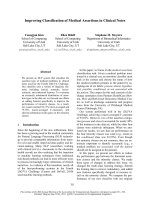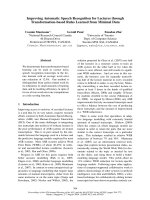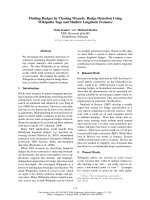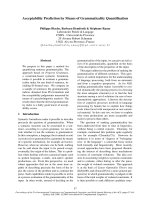Báo cáo khoa học: "Improving Summaries by Revising Them" potx
Bạn đang xem bản rút gọn của tài liệu. Xem và tải ngay bản đầy đủ của tài liệu tại đây (817.1 KB, 8 trang )
Improving Summaries by Revising Them
Inderjeet Mani and Barbara Gates and Eric Bloedorn
The MITRE Corporation
11493 Sunset Hills Rd.
Reston, VA 22090, USA
{imani,blgates,bloedorn}@mitre.org
Abstract
This paper describes a program which revises a
draft text by aggregating together descriptions
of discourse entities, in addition to deleting ex-
traneous information. In contrast to knowledge-
rich sentence aggregation approaches explored
in the past, this approach exploits statistical
parsing and robust coreference detection. In
an evaluation involving revision of topic-related
summaries using informativeness measures from
the TIPSTER SUMMAC evaluation, the results
show gains in informativeness without compro-
mising readability.
1 Introduction
Writing improves with revision. Authors are fa-
miliar with the process of condensing a long pa-
per into a shorter one: this is an iterative pro-
cess, with the results improved over successive
drafts. Professional abstractors carry out sub-
stantial revision and editing of abstracts (Crem-
rains 1996). We therefore expect revision to be
useful in automatic text summarization. Prior
research exploring the use of revision in sum-
marization, e.g., (Gabriel 1988), (Robin 1994),
(McKeown et al. 1995) has focused mainly on
structured data as the input. Here, we exam-
ine the use of revision in summarization of text
input.
First, we review some summarization termi-
nology. In revising draft summaries, these con-
densation operations, as well as stylistic reword-
ing of sentences, play an important role. Sum-
maries can be used to indicate what topics are
addressed in the source text, and thus can be
used to alert the user as to the source con-
tent (the
indicative
function). Summaries can
also be used to cover the concepts in the source
text to the extent possible given the compres-
sion requirements for the summary (the
in for-
mative
function). Summaries can be tailored to
a reader's interests and expertise, yielding
topic-
related
summaries, or they can be aimed at a
particular- usually broad - readership commu-
nity, as in the cash of (so-called)
generic
sum-
maries. Revision here applies to generic and
topic-related informative summaries, intended
for publishing and dissemination.
Summarization can be viewed as a text-to-
text reduction operation involving three main
condensation operations: selection of salient
portions of the text, aggregation of information
from different portions of the text, and abstrac-
tion of specific information with more general
information (Mani and Maybury 1999). Our
approach to revision is to construct an initial
draft summary of a source text and then to add
to the draft additional background information.
Rather than concatenate material in the draft
(as surface-oriented, sentence extraction sum-
marizers do), information in the draft is com-
bined and excised based on revision rules in-
volving aggregation (Dalianis and Hovy 1996)
and elimination operations. Elimination can
increase the amount of compression (summary
length/source length) available, while aggrega-
tion can potentially gather and draw in relevant
background information, in the form of descrip-
tions of discourse entities from different parts of
the source. We therefore hypothesize that these
operations can result in packing in more infor-
mation per unit compression than possible by
concatenation. Rather than opportunistically
adding as much background information that
can fit in the available compression, as in (Robin
1994), our approach adds background informa-
tion from the source text to the draft based on
an information weighting function.
Our revision approach assumes input sen-
tences are represented as syntactic trees whose
558
nodes are annotated with coreference informa-
tion. In order to provide open-domain cover-
age the approach does not assume a meaning-
level representation of each sentence, and so, un-
like many generation systems, the system does
not represent and reason about what is being
said 1. Meaning-dependent revision operations
are restricted to situations where it is clear from
coreference that the same entity is being talked
about.
There are several criteria our revision model
needs to satisfy. The final draft needs to be
informative, coherent,
and
grammatically well-
formed.
Informativeness is explored in Sec-
tion 4.2. We can also strive to guarantee, based
on our revision rule set, that each revision will
be syntactically well-formed. Regarding coher-
ence, revision alters rhetorical structure in a
way which can produce disfiuencies. As rhetori-
cal structure is hard to extract from the source 2,
our program instead uses coreference to guide
the revision, and attempts to patch the coher-
ence by adjusting references in revised drafts.
2 The Revision Program
The summary revision program takes as input
a source document, a draft summary specifi-
cation, and a target compression rate. Using
revision rules, it generates a revised summary
draft whose compression rate is no more than
above the target compression rate. The initial
draft summary (and background) are specified
in terms of a task-dependent weighting function
which indicates the relative importance of each
of the source document sentences. The program
repeatedly selects the highest weighted sentence
from the source and adds it to the initial draft
until the given compression percentage of the
source has been extracted, rounded to the near-
est sentence. Next, for each rule in the sequence
of revision rules, the program repeatedly applies
the rule until it can no longer be applied. Each
rule application results in a revised draft. The
program selects sentences for rule application by
giving preference to higher weighted sentences.
1Note that professional abstractors do not attempt to
fully "understand" the text - often extremely technical
material, but use surface-level features as above as well
as the overall discourse structure of the text (Cremmins
1996).
2However, recent progress on this problem (Marcu
1997) is encouraging.
A unary rule applies to a single sentence. A bi-
nary rule applies to a pair of sentences, at least
one of which must be in the draft, and where the
first sentence precedes the second in the input.
Control over sentence complexity is imposed by
failing rule application when the draft sentence
is too long, the parse tree is too deep 3, or if more
than two relative clauses would be stacked to-
gether. The program terminates when there are
no more rules to apply or when the revised draft
exceeds the required compression rate by more
than 5.
The syntactic structure of each source sen-
tence is extracted using Apple Pie 7.2 (Sekine
1998), a statistical parser trained on Penn Tree-
bank data. It was evaluated by (Sekine 1998)
as having 79% F-score accuracy (parseval) on
short sentences (less than 40 words) from the
Treebank. An informal assessment we made of
the accuracy of the parser (based on intuitive
judgments) on our own data sets of news ar-
ticles suggests about 66% of the parses were
acceptable, with almost half of the remain-
ing parsing errors being due to part-of-speech
tagging errors, many of which could be fixed
by preprocessing the text. To establish coref-
erence between proper names, named entities
are extracted from the document, along with
coreference relations using SRA's NameTag 2.0
(Krupka 1995), a MUC-6 fielded system. In ad-
dition, we implemented our own coreference ex-
tension: A singular definite NP (e.g., beginning
with "the", and not marked as a proper name)
is marked by our program as coreferential (i.e.,
in the same coreference equivalence class) with
the last singular definite or singular indefinite
atomic NP with the same head, provided they
are within a distance 7 of each other. On a cor-
pus of 90 documents, drawn from the TIPSTER
evaluation, described in Section 4.1 below, this
coreference extension scored 94% precision (470
valid coreference classes/501 total coreference
classes) on definite NP coreference. Also, "he"
(likewise "she") is marked, subject to 7, as
coreferential with the last person name men-
tioned, with gender agreement enforced when
the person's first name's gender is known (from
NameTag's list of common first names) 4. Most
3Lengths or depths greater than two standard devia-
tions beyond the mean are treated as too long or deep.
4 However, this very naive method was excluded from
559
rule-name:
rel-clause-intro-which- 1
patterns:
?X1 ; ~ first sentence pattern
?Y1 ?Y2 ?Y3 # second sentence pattern
tests:
label-NP ?X1 ; not entity-class ?X1 person ;
label-S ?Y1 ;
root ?Y1 ;
label-NP ?Y2 ;
label-VP ?Y3 ;
adjacent-sibling ?Y2 ?Y3 ;
parent-child ?Y1 ?Y2 ;
parent-child ?Y1 ?Y3 ;
coref ?X1 ?Y2
actions:
subs ?X1 (NP ?X1 (, -COMMA-)
(SBAR (WHNP (WP which))
(S ?Y3)) (,-COMMA-));
elim-root-of ?Y1 # removes second sentence
Figure 2: Relative Clause Introduction Rule
showing Aggregation and Elimination opera-
tions.
of the errors were caused by different sequences
of words between the determiner and the noun
phrase head word (e.g., "the factory" "the
cramped five-story pre-1915 factory" is OK, but
"the virus program"- "the graduate computer
science program" isn't).
3 Revision Rules
The revision rules carry out three types of op-
erations.
Elimination
operations eliminate con-
stituents from a sentence. These include elim-
ination of parentheticals, and sentence-initial
PPs and adverbial phrases satisfying lexical
tests (such as "In particular,", "Accordingly,"
"In conclusion," etc.) 5.
Aggregation
operations combine constituents
from two sentences, at least one of which must
be a sentence in the draft, into a new con-
stituent which is inserted into the draft sen-
tence. The basis for combining sentences is that
of referential identity: if there is an NP in sen-
tence i which is coreferential with an NP in
sentence j, then sentences i and j are candi-
dates for aggregation. The most common form
of aggregation is expressed as tree-adjunction
(Joshi 1998) (Oras 1999). Figures 1 and 2
show a relative clause introduction rule which
turns a VP of a (non-embedded) sentence whose
our analysis because of a system bug.
5Such lexical tests help avoid misrepresenting the
meaning of the sentence.
subject is coreferential with an NP of an ear-
lier (draft) sentence into a relative clause mod-
ifier of the draft sentence NP. Other appositive
phrase insertion rules include copying and in-
serting nonrestrictive relative clause modifiers
(e.g., "Smith,
who ,"),
appositive modifiers of
proper names (e.g., "Peter G. Neumann,
a com-
puter security expert familiar with the case, "),
and proper name appositive modifiers of definite
NPs (e.g., "The network,
named ARPANET,
is
operated by ").
Smoothing
operations apply to a single sen-
tence, performing transformations so as to ar-
rive at more compact, stylistically preferred sen-
tences. There are two types of smoothing.
Reduction
operations simplify coordinated con-
stituents. Ellipsis rules include subject ellipsis,
which lowers the coordination from a pair of
clauses with coreferential subjects to their VPs
(e.g., "The rogue computer program destroyed
files over a five month period and the program
infected close to 100 computers at NASA fa-
cilities" ==~ "The rogue computer program de-
stroyed files over a five month period and in-
fected close to 100 computers at NASA facil-
ities"). It usually applies to the result of an
aggregation rule which conjoins clauses whose
subjects are coreferential. Relative clause re-
duction includes rules which apply to clauses
whose VPs begin with "be" (e.g., "which is"
is deleted) or "have" (e.g., "which have" : ,~
"with"), as well as for other verbs, a rule delet-
ing the relative pronoun and replacing the verb
with its present participle (i.e., "which V" ,~
"V+ing"). Coordination rules include relative
clause coordination.
Reference Adjustment op-
erations fix up the results of other revision oper-
ations in order to improve discourse-level coher-
ence, and as a result, they are run last 6. They
include substitution of a proper name with a
name alias if the name is mentioned earlier, ex-
pansion of a pronoun with a coreferential proper
name in a parenthetical ("pronoun expansion"),
and ("indefinitization") replacement of a def-
inite NP with a coreferential indefinite if the
definite occurs without a prior indefinite.
SSuch operations have been investigated earlier by
(Robin 1994).
560
Draft
sentence
Other
sentence
S
N'P vP
$1
1,IPl 'VPI
( ~m~
NP2 vP
NP SBAR
\
S
J ~ vP1
Rexult
sentence
Figure 1: Relative Clause Introduction showing tree NP2 being adjoined into tree S
4 Evaluation
Evaluation of text summarization and other
such NLP technologies where there may be
many acceptable outputs, is a difficult task. Re-
cently, the U.S. government conducted a large-
scale evaluation of summarization systems as
part of its TIPSTER text processing program
(Mani et al. 1999), which included both an
extrinsic (relevance assessment) evaluation, as
well as an intrinsic (coverage of key ideas)
evaluation. The test set used in the latter
(Q&:A) evaluation along with several automat-
ically scored measures of informativeness has
been reused in evaluating the informativeness
of our revision component.
4.1 Background: TIPSTER Q&A
Evaluation
In this Q&A evaluation, the summarization sys-
tem, given a document and a topic, needed to
produce an informative, topic-related summary
that contained the correct answers found in that
document to a set of topic-related questions.
These questions covered "obligatory" informa-
tion that has to be provided in any document
judged relevant to the topic. The topics chosen
(3 in all) were drawn from the TREC (Harman
and Voorhees 1996) data sets. For each topic,
30 relevant TREC documents were chosen as
the source texts for topic-related summariza-
tion. The principal tasks of each Q&A evaluator
were to prepare the questions and answer keys
and to score the system summaries. To con-
struct the answer key, each evaluator marked
off any passages in the text that provided an an-
swer to a question (example shown in Table 1).
Two kinds of scoring were carried out. In
the first, a manual method, the answer to each
question was judged Correct, Partially Correct,
or Missing based on guidelines involving a hu-
man comparison of the summary of a docu-
ment against the set of tagged passages for that
question in the answer key for that document.
The second method of scoring was an automatic
method. This program 7 took as input a key file
and a summary to be scored, and returns an
informativeness score on four different metrics.
The key file includes tags identifying passages
in the file which answer certain questions. The
scoring uses the overlap measures shown in Ta-
ble 2 s. The automatically computed V4 thru
V7 informativeness scores were strongly corre-
lated with the human-evaluated scores (Pearson
r > .97, ~ < 0.0001). Given this correlation, we
decided to use these informativeness measures.
4.2 Revision Evaluation:
Informativeness
To evaluate the revised summaries, we first con-
verted each summary into a weighting function
which scored each full-text sentence in the sum-
mary's source in terms of its similarity to the
most similar summary sentence. The weight
of a source document sentence s given a sum-
7The program was reimplemented by us for use in the
revision evaluation.
S Passage matching here involves a sequential
match
with stop words and punctuation removed.
561
Title
: Computer Security
Description
: Identify instances of illegal entry into sensitive
computer networks by nonauthorized personnel.
Narrative
: Illegal entry into sensitive computer networks
is a serious and potentially menacing problem. Both 'hackers' and
foreign agents have been known to acquire unauthorized entry into
various networks. Items relative this subject would include but not
be limited to instances of illegally entering networks containing
information of a sensitive nature to specific countries, such as
defense or technology information, international banking, etc. Items
of a personal nature (e.g. credit card fraud, changing of college
test scores) should not be considered relevant.
Questions
1)Who is the known or suspected hacker accessing a sensitive computer or computer network?
2) How is the hacking accomplished or putatively achieved?
3) Who is the apparent target of the hacker?
4) What did the hacker accomplish once the violation occurred?
What was the purpose in performing the violation?
5) What is the time period over which the breakins were occurring?
As a federal
grand jury
decides whether he should be prosecuted, <Ol>a graduate
student</Ql> linked to a ''virus'' that disrupted computers nationwide <Q5>last
month</q5>has been teaching his lawyer about the technical subject and turning down
offers for his life story No charges have been filed against <ql>Norris</Ql>,
who reportedly told friends that he designed the virus that temporarily clogged about
<Q3>6,000 university and military computers</q3> <Q2>linked to the Pentagon's hrpanet
network</Q2>
Table 1: Q&A Topic 258, topic-related questions, and part of a relevant source document showing
answer key annotations.
Overlap
Metric
V4
V5
Definition
full credit if the text spans for all tagged key passages
are found in their entirety in the summary
full credit if the text spans for all tagged key passages
are found in their entirety in the summary;
haft credit if the text spans for all tagged key passages
are found in some combination of full or truncated form in the summary
full credit if the text spans for all tagged key passages
are found in some combination of full or truncated form in the summary
percentage of credit assigned that is commensurate with the extent to which
the text spans for tagged key passages are present in the summary
Table 2: Informativeness measures for Automatic Scoring of each question that has an answer
according to the key.
Party
CGI/CMU
Cornell/SabIR
GE 15.43
ISI 19.57
NMSU 16.54
SRA 15.59
UPenn 16.29
Mean 16.48
FOG Kincaid
Before
After Before
16.49 15.50 13.22
15.51 15.08 12.15
15.14 12.13
17.94 16.18
15.52 13.32
15.29 12.26
16.21 12.93
15.82 13.15
After
12.23
11.71
11.87
14.51
12.30
11.99
12.83
12.51
Table 3: Readability of Summaries Before (Original Summary) and After Revision (A+E). Overall,
both FOG and Kincaid scores show a slight but statistically significant drop on revision (~ <: 0.05).
562
100%
90%
80%
70%
60%
50%
40%
30%
20%
10%
0%
i
X A ~+]E X h. &+Z Z ,~ j~+~r Z ~. .K+][
~Lose
•
M alntain
IWiu
Figure 3: Gains in Compression-Normalized Informativeness of revised summaries compared to
initial drafts. E elimination, A - aggregation. A, E, and A+E are shown in the order V4, V5,
V6, and V7.
<sl> Researchers today tried to trace a "virus" that infected computer systems nationwide,
<Q4> slowing machines in universities, a NASA and nuclear weapons lab and other federal
research centers linked by a Defense Department computer network. </q4> <s3>
Authorities said the virus, which <FROM S16> <Q3> the virus infected only unclassified
computers </Q3> and <FROM $15> <Q3> the virus affected the unclassified,
non-secured computer systems </q3> (and which <FROM S19> <Q4> the virus was %nainly just
slowing down systems ) and slowing data ", </Q4> apparently <q4> destroyed no data but temporarily
halted some research. </Q4> <s14>. The computer problem also was discovered late
Wednesday at the <q3> Lawrence Livermore National Laboratory in Livermore, Calif. </Q3>
<s15> <s20> "the developer was clearly a very high order hacker,", <FROM $25>
<QI> a
graduate student </QI> <Q2> who made making a programming error in designing the
virus,causing the program to replicate faster than expected </q2> or computer buff, said
John McAfee, chairman of the Computer Virus Industry Association in Santa Clara, Calif
<s24> The Times reported today that the anonymous caller an anonymous caller to
the paper said his associate was responsible for the attack and had meant it to
be harmless.
Figure 4: A revised summary specified in terms of an original draft (plain text) with added (bold-
face) and deleted (italics) spans. Sentence <s> and Answer Key <Q> tags are overlaid.
mary is the match score of s's best-matching
summary sentence, where the match score is
the percentage of content word occurrences in
s that are also found in the summary sentence.
Thus, we constructed an idealized model of
each summary as a sentence extraction function.
Since some of the participants truncated and
occasionally mangled the source text (in addi-
tion, Penn carried out pronoun expansion), we
wanted to avoid having to parse and apply revi-
sion rules to such relatively ill-formed material.
This idealization is highly appropriate, for each
of the summarizers considered 9 did carry out
sentence extraction; in addition, it helps level
the playing field, avoiding penalization of indi-
vidual summarizers simply because we didn't
cater to the particular form of their summary.
Each summary was revised by calling the re-
vision program with the full-text source, the
original compression rate of the summary, and
9TextWise, which extracted named entities rather
than passages, was excluded.
563
the summary weighting function (i.e., with the
weight for each source sentence). The 630 re-
vised summaries (3 topics x 30 documents per
topic × 7 participant summaries per document)
were then scored against the answer keys using
the overlap measures above. The documents
consisted of AP, Wall Street Journal, and Fi-
nancial Times news articles from the TREC
(Harman and Voorhees 1996) collection.
The rules used in the system are very gen-
eral, and were not modified for the evaluation
except for turning off most of the reference ad-
justment rules, as we wished to evaluate that
component separately. Since the answer keys
typically do not contain names of commenta-
tors, we wanted to focus the algorithm away
from such names (otherwise, it would aggregate
information around those commentators). As
a result, special rules were written in the revi-
sion rule language to detect commentator names
in reported speech ("X said that ", "X said
", ", said X ", ", said X ", etc.), and these
names were added to a stoplist for use in enti-
tyhood and coreference tests during regular re-
vision rule application.
Figure 3 shows percentage of losses, main-
tains, and wins in informativeness against the
initial draft (i.e., the result of applying the com-
pression to the sentence weighting function).
Informativeness using V7 is measured by V71°
normalized for compression as:
sl
nV7 = V7 *
(1 - ~-~) (1)
where sl is summary length and sO is the source
length. This initial draft is in itself not as in-
formative as the original summary: in all cases
except for Penn on 257, the initial draft either
maintains or loses informativeness compared to
the original summary.
As Figure 3 reveals (e.g., for nVT), revising
the initial draft using elimination rules only (E)
results in summaries which are less informative
than the initial draft 65% of the time, suggest-
ing that these rules are removing informative
material. Revising the initial draft using aggre-
gation rules alone (A), by contrast, results in
more informative summaries 47% of the time,
and equally informative summaries another 13%
1°V7 computes for each question the percentage of
its answer passages completely covered by the summary.
This normalization is extended similarly for V4 thru V6.
of the time. This is due to aggregation folding in
additional informative material into the initial
draft when it can. Inspection of the output sum-
maries, an example of which is shown in Fig-
ure 4, confirms the folding in behavior of aggre-
gation. Finally, revising the initial draft using
both aggregation and elimination rules (ATE)
does no more than maintain the informative-
ness of the initial draft, suggesting A and E are
canceling each other out. The same trend is ob-
serving for nV4 thru nV6, confirming that the
relative gain in informativeness due to aggrega-
tion is robust across a variety of (closely related)
measures. Of course, if the revised summaries
were instead radically different in wording from
the original drafts, such informativeness mea-
sures would, perhaps, fall short.
It is also worth noting the impact of aggrega-
tion is modulated by the current control strat-
egy; we don't know what the upper bound is
on how well revision could do given other con-
trol regimes. Overall, then, while the results
are hardly dramatic, they are certainly encour-
aging zl.
4.3 Revision Evaluation: Readability
Inspection of the results of revision indicates
that the syntactic well-formedness revision cri-
terion is satisfied to a very great extent. Im-
proper extraction from coordinated NPs is an
issue (see Figure 4), but we expect additional
revision rules to handle such cases. Coher-
ence disfiuencies do occur; for example, since we
don't resolve possessive pronouns or plural def-
inites, we can get infelicitous revisions like "A
computer virus, which entered
,their comput-
ers
through ARPANET, infected systems from
MIT." Other limitations in definite NP coref-
erence can and do result in infelicitous refer-
ence adjustments. For one thing, we don't link
definites to proper name antecedents, result-
ing in inappropriate indefinitization (e.g., "Bill
Gates
*A computer tycoon").
In addition,
the "same head word" test doesn't of course ad-
dress inferential relationships between the defi-
nite NP and its antecedent (even when the an-
tecedent is explicitly mentioned), again result-
ing in inappropriate indefinitization (e.g., "The
program a
developer ~',
and "The developer
11 Similar results hold while using a variety of other
compression normalization metrics.
564
An anonymous caller said
.a very high order
hacker
was a graduate student").
To measure fluency without conducting an
elaborate experiment involving human judg-
mentsl we fell back on some extremely coarse
measurea based on word and sentence length
computed by the (gnu) unix program
style
(Cherry 1981). The FOG index sums the av-
erage sentence length with the percentage of
words over 3 syllables, with a "grade" level over
12 indicating difficulty for the average reader.
The Kincaid index, intended for technical text,
computes a weighted sum of sentence length and
word length. As can be seen from Table 3, there
is a slight but significant lowering of scores on
both metrics, revealing that according to these
metrics revision is not resulting in more com-
plex text. This suggests that elimination rather
than aggregation is mainly responsible for this.
5 Conclusion
This paper demonstrates that recent advances
in information extraction and robust parsing
can be exploited effectively in an open-domain
model of revision inspired by work in natural
language generation. In the future, instead of
relying on adjustment rules for coherence, it
may be useful to incorporate a level of text plan-
ning. We also hope to enrich the background
information by merging information from mul-
tiple text and structured data sources.
References
Cherry, L.L., and Vesterman, W.
Writing Tools:
The STYLE and DICTION programs,
Com-
puter Science Technical Report 91, Bell Lab-
oratories, Murray Hill, N.J. (1981).
Cremmins, E. T. 1996.
The Art of Abstracting.
Information Resources Press.
Dalianis, H., and Hov, E. 1996.
Aggregation in
Natural Language Generation.
In Zock, M.,
and Adorni, G., eds., Trends in Natural Lan-
guage Generation: an Artificial Intelligence
Perspective, pp.88-105. Lecture Notes in Ar-
tificial Intelligence, Number 1036, Springer
Verlag, Berlin.
Dras, M. 1999. Tree Adjoining Grammar and
the Reluctant Paraphrasing of Text, Ph.D.
Thesis, Macquarie University, Australia.
Gabriel, R. 1988. Deliberate Writing. In Mc-
Donald, D.D., and Bolc, L., eds., Natu-
ral Language Generation Systems, Springer-
Verlag, NY.
Harman, D.K. and E.M. Voorhees. 1996. The
fifth text retrieval conference (trec-5).
Na-
tional Institute of Standards and Technology
NIST SP 500-238.
Joshi, A. K. and Schabes, Y. 1996. "Tree-
Adjoining Grammars". In Rosenberg, G., and
Salomaa, A., eds., Handbook of Formal Lan-
guages, Vol. 3, 69-123. Springer-Verlag, NY.
Krupka, G. 1995. "SRA: Description of the SRA
System as Used for MUC-6", Proceedings of
the Sixth Message Understanding Conference
(MUC-6), Columbia, Maryland, November
1995.
Marcu, D. 1997. From discourse structures to
text summaries,
in Mani, L and Maybury,
M., eds., Proceedings of the ACL/EACL '97
Workshop on Intelligent Scalable Text Sum-
marization.
Mani, I. and M. Maybury, eds. 1999.
Ad-
vances in Automatic Text Summarization.
MIT Press.
Mani, I., Firmin, T., House, D., Klein, G.,
Hirschman, L., and Sundheim, B. 1999.
"The TIPSTER SUMMAC Text Summariza-
tion Evaluation", Proceedings of EACL'99,
Bergen, Norway, June 8-12, 1999.
McKeown, K., J. Robin, and K. Kukich. 1995.
Generating Concise Natural Language Sum-
maries.
Information Processing and Manage-
ment, 31, 5, 703- 733.
Robin, J. 1994. Revision-based generation of
natural language summaries providing his-
torical background: corpus-based analysis,
design and implementation. Ph.D. Thesis,
Columbia University.
Sekine, S. 1998. Corpus-based Parsing and Sub-
language Studies. Ph.D. Dissertation, New
York University, 1998.
565

